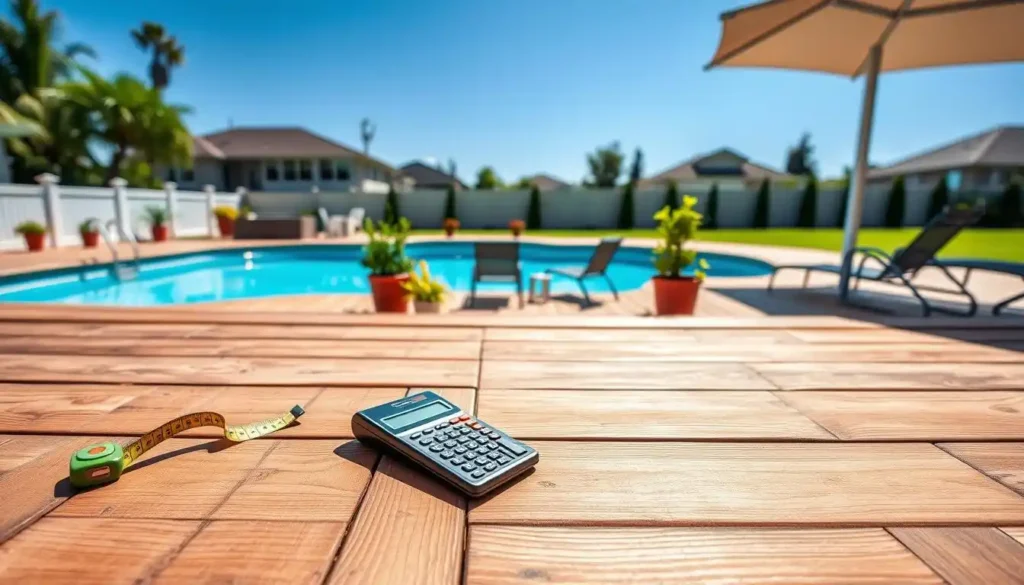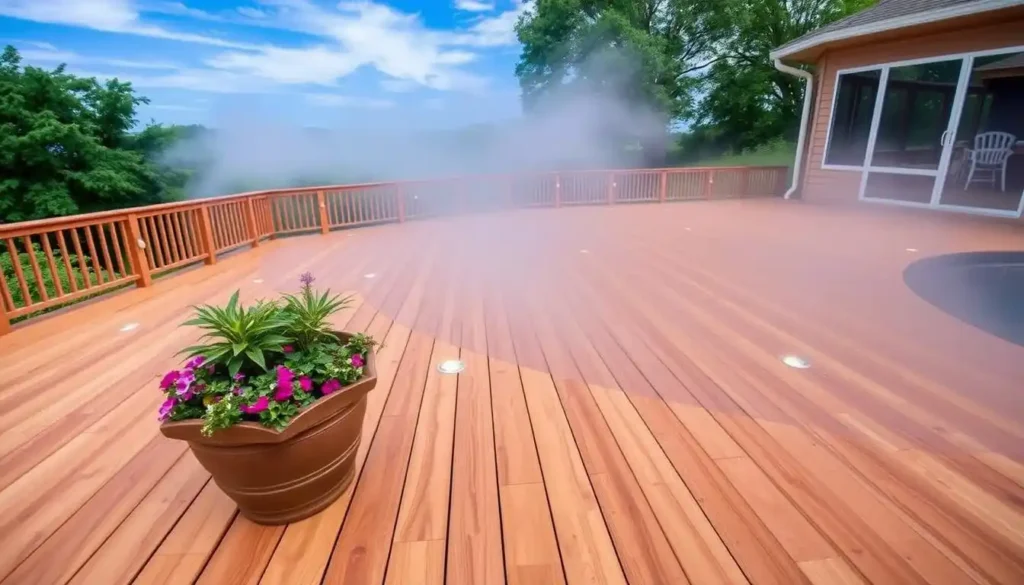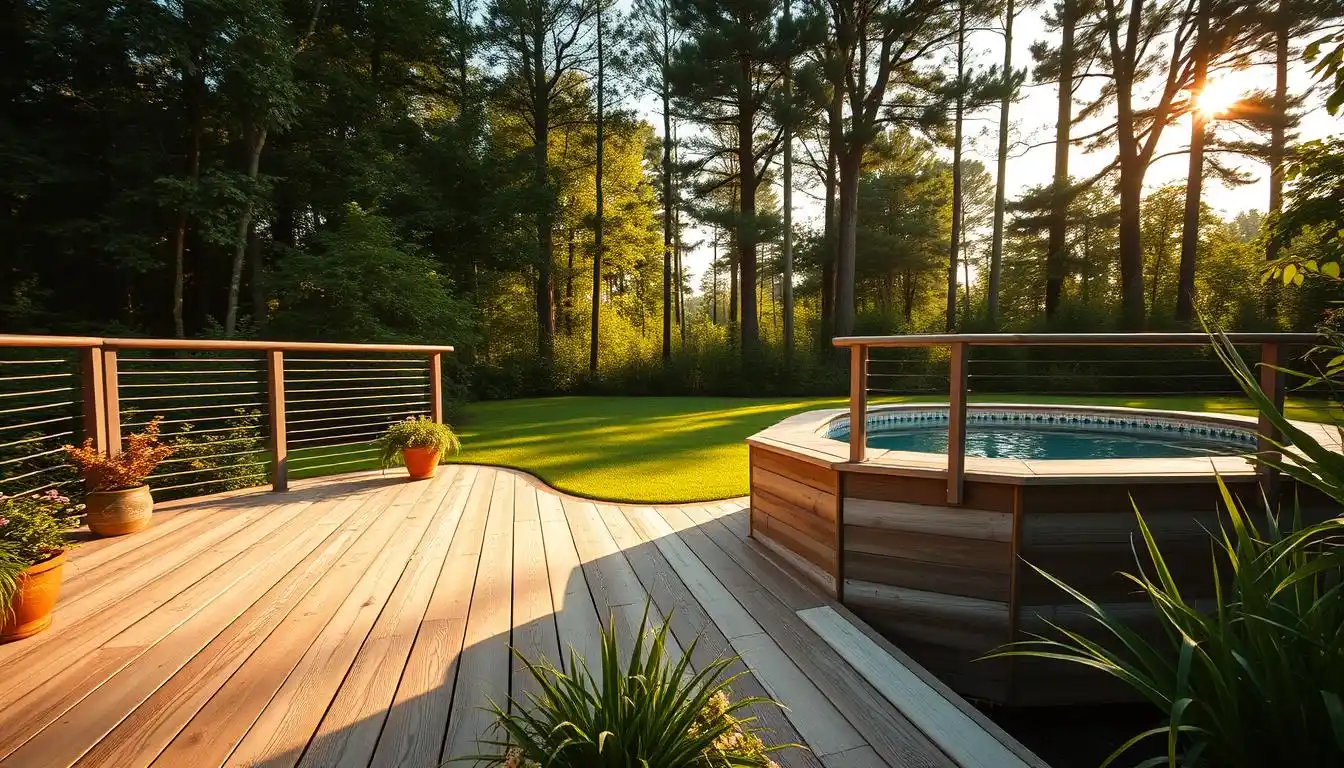Building a pool deck can lead to big mistakes. These errors can affect the safety, durability, and cost of your project. Many homeowners don’t realize how complex building an aboveground pool deck can be. This leads to costly mistakes.
To avoid these mistakes, knowing common errors is key. Issues like permit and code violations, and wrong material choices can increase costs. Being informed can help you save money and enjoy your pool deck for many years.
Key Takeaways
- Avoid costly mistakes when building your pool deck.
- Understand the true cost of your aboveground pool deck project.
- Be aware of permit and code violations that can impact your project.
- Make informed decisions about material selection.
- Ensure your pool deck is safe and durable.
Understanding the True Cost of Aboveground Pool Decks
Planning an aboveground pool deck? It’s key to know the real cost. The cost isn’t just the initial setup. Many factors can affect your budget.
Average Investment vs. Reality: The Price Gap
The cost of an aboveground pool deck varies a lot. Homeowners often find a gap between what they expect to pay and the actual cost. This gap comes from things like materials, labor, and permits.
For example, material costs can be between $15 to $35 per square foot. This depends on the type and quality you choose.
| Material Type | Cost per Square Foot |
|---|---|
| Pressure-Treated Wood | $15-$25 |
| Composite Decking | $25-$35 |
Hidden Expenses That Blow Your Budget
There are hidden costs that can surprise you. These include permit fees, electrical and lighting setups, and possible repairs or upgrades. For example, ensuring proper drainage can add to the cost but is essential for safety and longevity.

Permit and Code Violations: The $10,000+ Mistake
Building an aboveground pool deck? Knowing about permits and codes is key to avoid big mistakes. Not following these rules can cost you over $10,000.
Building codes and permits differ by area. They ensure your deck is safe and sturdy. Knowing these rules can save you from expensive fixes and fines.
Local Building Codes You Can’t Ignore
Local building codes set safety standards for construction, like pool decks. They cover deck height, railing needs, and material choices. For example, many places require decks to use rot-resistant lumber.
Permit Requirements for Aboveground Pool Decks
You need a building permit before starting. You’ll submit your deck plans for review. Not getting the right permits can lead to fines and deck removal.

The Cost of Retroactive Compliance and Fines
Not following codes or missing permits can cost a lot. You might face fines and have to change or remove your deck. This can cost more than $10,000.
| Violation Type | Average Fine | Retroactive Compliance Cost |
|---|---|---|
| No Building Permit | $500 – $2,000 | $1,000 – $5,000 |
| Non-Compliant Materials | $1,000 – $3,000 | $2,000 – $6,000 |
| Inadequate Safety Features | $2,000 – $5,000 | $3,000 – $8,000 |
By following local building codes and getting the right permits, you can avoid these big costs. This ensures your pool deck is safe and meets all requirements.
Material Selection Blunders for Aboveground Pool Decks
Choosing the right materials for your aboveground pool deck is key. It affects both the deck’s durability and cost. The wrong picks can cause early wear, higher upkeep, and safety risks.

Pressure-Treated Wood: False Economy
Pressure-treated wood seems cheap at first. But, it needs constant care to avoid rot and bugs. This upkeep can cost more over time, making it not worth it.
Composite Decking: Worth the Premium?
Composite decking costs more but lasts longer and needs little care. It fights off rot, bugs, and color loss. Many see the long-term gains as worth the extra start-up cost.
Metal Components: Corrosion Concerns Near Pools
Metal near pools faces corrosion risks from water and chemicals. It’s smart to pick materials that resist corrosion or use protective coatings.
Material Lifespan vs. Initial Cost Analysis
It’s wise to weigh a material’s lifespan against its initial cost. This helps make better choices. Below is a table comparing different materials based on cost, lifespan, and upkeep.
| Material | Initial Cost | Lifespan | Maintenance Requirements |
|---|---|---|---|
| Pressure-Treated Wood | Low | 10-15 years | High |
| Composite Decking | High | 25-30 years | Low |
| Metal Components | Moderate | 15-20 years | Moderate |
Structural Support Failures That Compromise Safety
Your aboveground pool deck needs strong support to be safe. It’s important to build it with safety in mind. This helps prevent accidents and keeps the structure strong.
Inadequate Footings and Foundation Issues
Footings and foundations are key to a deck’s stability. If they’re not right, the deck can settle or even collapse. Make sure footings are deep and sized for the deck’s weight.
Improper Joist Spacing and Load Capacity
Joists support the decking. Improper joist spacing can cause sagging or collapse. For pool decks for above ground pools, remember to add extra weight for people and furniture.
Beam Sizing Errors and Their Consequences
Beams help spread the deck’s load. If they’re too small, the deck can fail. Always size beams correctly for the deck’s design and load.
Fixing these issues makes your aboveground pool deck safer and more durable. Regular checks and upkeep help spot and fix problems early.
Water Drainage Oversights Around Your Pool Deck
A good drainage system around your pool deck is key to avoiding expensive fixes and keeping everyone safe. Water buildup can cause erosion and harm your deck’s structure.
Slope and Grading Requirements
It’s important to have the right slope and grading around your pool deck. A slope of 1-2% helps water flow away from the deck. You can achieve this by adjusting the ground during construction.
Drainage System Options and Costs
There are many drainage systems to choose from, like French drains, swales, and catch basins. The best one depends on your deck’s design, the land around it, and local rules. Prices can range from $500 for simple setups to over $5,000 for more complex ones.
| Drainage System | Cost Range | Complexity |
|---|---|---|
| French Drain | $1,000 – $3,000 | Moderate |
| Swale | $500 – $2,000 | Low |
| Catch Basin | $2,000 – $5,000 | High |
Preventing Erosion Under Your Deck
To stop erosion under your deck, think about using geotextiles or riprap. Geotextiles are special fabrics that keep the soil in place. Riprap involves placing rocks or stones around the deck. Both can work well, depending on your location.
Pool-to-Deck Connection Mistakes
Building an aboveground pool deck requires a strong connection between the deck and the pool. This connection is key to avoiding problems later. A good connection means your pool will last longer and be safer.
Gap Requirements Between Deck and Pool
It’s important to have the right gap between the deck and pool. This gap stops water from getting in and causing damage. The size of the gap depends on local rules and the deck material. A gap of 1/4 to 1/2 inch is usually best.
This size gap lets water drain while keeping debris out.
Proper Flashing and Waterproofing Techniques
Flashing and waterproofing around the pool-to-deck connection are vital. They keep water from seeping in. Use flashing that matches your deck and install it right to keep water away.
Also, apply a waterproof sealant around the gap. This makes the connection last longer.
Expansion and Contraction Accommodation
Decks and pools change size with temperature changes. This can stress the connection between them. To handle this, use fasteners that can stretch a bit.
Or, design the deck with joints to move with the pool. This helps the connection stay strong.
By focusing on these key connection points, you can make your pool deck safer, more durable, and look better. Whether you’re starting from scratch or updating your deck, paying attention to these details is worth it.
Safety Feature Omissions That Lead to Liability
Adding safety features to your aboveground pool deck is very important. Without them, serious problems can happen. It’s not just about following rules; it’s about keeping your family and friends safe.
Gate and Fence Requirements by Code
Building codes set rules for gates and fences around pools. They talk about height, material, and how gates lock. For example, fences must be at least 4 feet tall and gates must lock by themselves and be out of kids’ reach.
Following these rules is key to avoid fines and to keep everyone safe.
Non-Slip Surface Options and Installation
It’s important to have surfaces around your pool that prevent slipping. You can use textured concrete, rubber mats, or special deck coatings. Making sure these surfaces are installed right is crucial.
Also, keeping them clean and applying non-slip coatings when needed is important.
Railing Height and Spacing Regulations
Railings around your pool deck must meet certain height and spacing rules. They should be between 36 and 42 inches high, with no more than 4 inches between balusters. This helps stop kids from falling off.
Checking that your deck meets these standards is vital for safety and to protect you from legal issues.
DIY Disasters When Building a Pool Deck
Building an aboveground pool deck yourself can be tough and full of risks. Saving money by doing it yourself might seem good, but the costs of mistakes can be high. These costs can easily outweigh any savings.
Common Measurement and Leveling Errors
One big problem is making mistakes with measurements and leveling. Inaccurate measurements can cause the deck to be uneven. This can lead to water pooling on one side and structural problems. It’s key to double-check your measurements and use a level to make sure your deck is even.
Tool Limitations for Amateur Builders
Amateur builders often don’t realize the need for the right tools. Using the wrong tools can lead to poor workmanship and safety risks. For instance, using a circular saw without a guide can cause uneven cuts. This can weaken your deck’s structure.
Time and Labor Miscalculations
Many people underestimate how much time and effort building a pool deck takes. This can lead to rushed work, mistakes, and burnout. To avoid this, make a realistic timeline and consider getting professional help if needed.
When to Recognize You Need Professional Help
If you’re unsure about any part of building your pool deck, it’s crucial to know when to ask for help. Signs you need help include:
- Uncertainty about local building codes and regulations
- Lack of experience with necessary tools and techniques
- Insufficient time or labor to complete the project safely and correctly
By knowing your limits and asking for help when needed, you can avoid costly mistakes. This way, your aboveground pool deck will be safe and fun to use.
Electrical and Lighting Installation Hazards
Electrical and lighting setups around aboveground pool decks can be dangerous if not done right. It’s important to follow safety codes when building a pool deck. You need to think about the electrical parts and lights you’ll use.
Code Requirements for Pool Deck Electrical
It’s crucial to know and follow local electrical codes for safety. These codes set rules for electrical work near water, like aboveground pool decks. They cover wiring, outlets, and lights to avoid electrical shock.
- GFCI protection for all electrical outlets within a certain distance of the pool
- Proper waterproofing of electrical components
- Specific height requirements for lighting fixtures
GFCI Protection and Waterproofing Essentials
Ground Fault Circuit Interrupter (GFCI) protection is key for electrical work near pools. GFCI devices stop the circuit if they find a ground fault to prevent shock. Waterproofing is also key to keep electrical parts dry.
Installing GFCI-protected outlets and waterproof lights can greatly lower electrical hazard risks.
Proper Conduit and Junction Box Installation
Installing conduits and junction boxes needs careful planning and doing. They must be safe for wet places and meet local electrical codes. It’s important to seal them well to keep water out and ensure electrical safety.
| Component | Requirement | Benefit |
|---|---|---|
| GFCI Outlets | Installation near pool | Prevents electrical shock |
| Waterproof Lighting | Use in wet locations | Reduces risk of electrical hazards |
| Conduits and Junction Boxes | Proper sealing and protection | Maintains electrical safety |
Weather Protection Negligence for Aboveground Pool Decks
Weather can really affect your aboveground pool deck’s life if it’s not protected. Not taking care of your deck can cause it to wear out faster, cost you money, and even be dangerous. It’s key to know how weather can harm your deck and take steps to protect it.
UV Damage Prevention Strategies
UV rays can damage your deck’s surface, making it fade, crack, and wear down. To stop this, use a UV-resistant sealant or stain. Also, keep your deck clean and free of dirt to lessen UV damage. As Mark Johnson, a renowned pool maintenance expert, advises, “Using UV-resistant materials and regular upkeep can greatly extend your deck’s life.”
Freeze-Thaw Cycle Protection Methods
In cold areas, the freeze-thaw cycle can harm your deck, causing cracks and damage. Make sure your deck is made to resist freezing. Use materials that can handle cold and apply a waterproof sealant. Also, drain water from the deck and around it in winter to stop ice and damage.
Hurricane and High Wind Reinforcement
If you live in a place with hurricanes or strong winds, you need to strengthen your deck. Secure the deck to the ground or buildings, use materials that can handle wind, and design it to withstand high winds. A study found that proper reinforcement can cut damage risk by up to 70%. Regular checks and upkeep are also important to keep your deck safe and sound.
By using these weather protection tips, you can make your aboveground pool deck last longer and stay safe. This way, it will remain a fun and safe place for many years.
Maintenance Shortcuts That Accelerate Deterioration
Keeping your aboveground pool deck in good shape is key. A regular maintenance routine can stop early wear and save you money on repairs later.
Improper Cleaning Techniques and Chemicals
Wrong cleaning methods and chemicals can harm your deck. Avoid harsh chemicals that can remove protective sealants. Use gentle cleaning products made for your deck’s material instead. Regular sweeping and cleaning with the right solutions keep your deck strong.
Sealing and Staining Schedule Failures
Not sticking to a sealing and staining schedule can let your deck get damaged. Seal your deck as the maker suggests to protect it from water and UV rays. Staining not only looks good but also protects your deck.
Ignoring Early Warning Signs of Damage
Not paying attention to early damage signs, like cracks or color changes, can cause bigger problems. Regular inspections help you spot issues early, saving you from expensive fixes. Fixing these signs quickly can make your pool deck last longer.
By avoiding these common mistakes and sticking to a good maintenance plan, your aboveground pool deck will stay safe and fun for years. Think about getting help from a pro for deck ideas and care tips that fit your deck’s needs.
Conclusion: Protecting Your Aboveground Pool Deck Investment
Protecting your aboveground pool deck is all about careful planning. Avoiding common mistakes and knowing local rules are key. Choosing the right materials is also important.
When building your deck, think about drainage, support, and safety. This ensures your deck is safe and fun for everyone.
Above ground pools with decks can really enhance your outdoor area. Look for deck ideas that are both useful and beautiful. Whether you want a simple or complex deck, knowing how to build it is essential.
There are many designs for pool decks. Pick one that fits your needs and style.
By following this article, you can build a stunning and lasting pool deck. Remember, keeping your deck in good shape is crucial. Regular checks and maintenance will help it last longer and stay safe.
FAQ
What are the most common mistakes to avoid when building an aboveground pool deck?
Don’t ignore local building codes and permits. Choose the right materials and ensure proper support. Also, don’t forget about water drainage and safety.
How much does an aboveground pool deck typically cost?
The cost varies based on materials, labor, and permits. Knowing the average cost helps with planning and budgeting.
What are the consequences of ignoring permit and code violations for my aboveground pool deck?
Ignoring these can lead to fines and extra costs. These can be over $10,000.
What materials are best suited for building an aboveground pool deck?
Choose materials based on durability, maintenance, and cost. Options include pressure-treated wood, composite decking, and metal.
How can I ensure the structural integrity of my aboveground pool deck?
Make sure footings, foundation, joist spacing, and beam sizing are correct. This keeps your deck strong.
What are the key considerations for water drainage around my aboveground pool deck?
Use the right slope and grading. Choose a good drainage system. Prevent erosion under the deck to avoid water damage.
How do I properly connect my aboveground pool to the deck?
Ensure the correct gap between the deck and pool. Use proper flashing and waterproofing. Accommodate expansion and contraction for a good connection.
What safety features are required for aboveground pool decks?
You need gates and fences by code. Use non-slip surfaces. Follow railing height and spacing rules.
Should I build my aboveground pool deck myself or hire a professional?
DIY can save money, but consider the complexity. Know when to hire a pro to avoid costly mistakes and ensure safety.
What are the hazards associated with electrical and lighting installations around aboveground pool decks?
Electrical and lighting work can be dangerous if not done right. Watch for code issues, GFCI problems, and wrong conduit and box installation.
How can I protect my aboveground pool deck from various weather conditions?
Use UV protection, prevent freeze-thaw damage, and reinforce against strong winds. This keeps your deck in good shape.
What maintenance routine should I follow to preserve my aboveground pool deck?
Clean, seal, and stain regularly. Fix damage early to keep your deck looking great and lasting longer.

